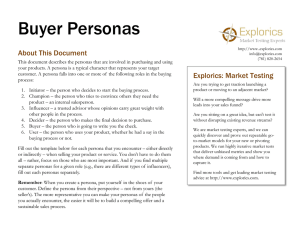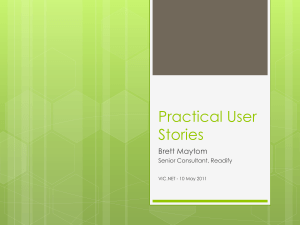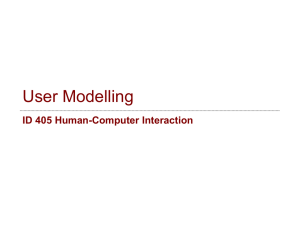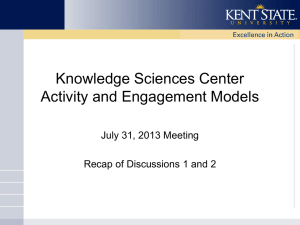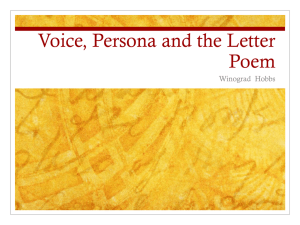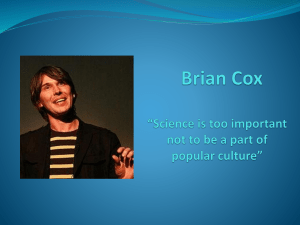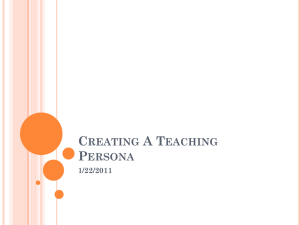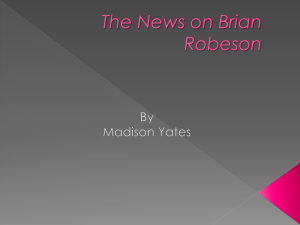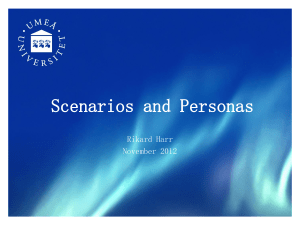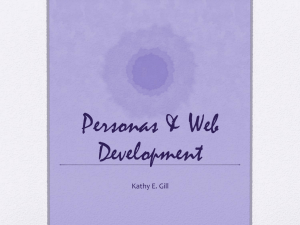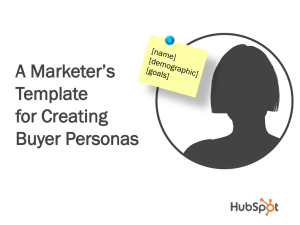PowerPoint 811 KB
advertisement
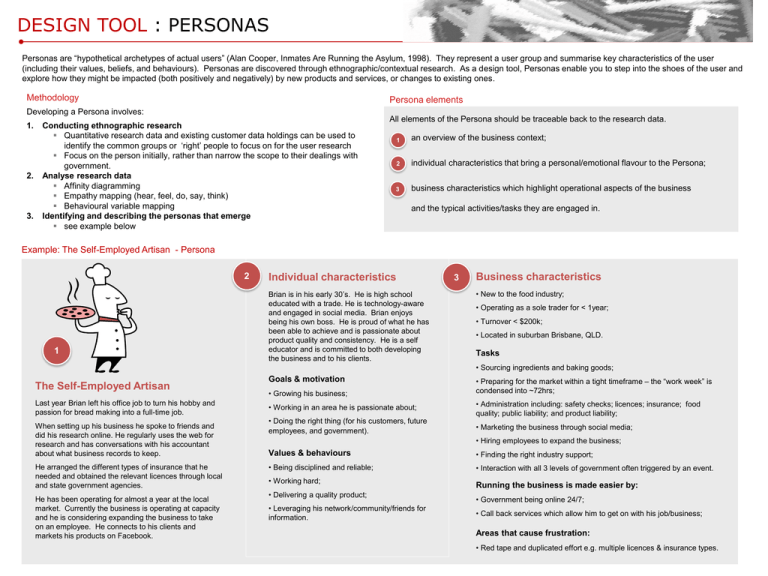
DESIGN TOOL : PERSONAS Personas are “hypothetical archetypes of actual users” (Alan Cooper, Inmates Are Running the Asylum, 1998). They represent a user group and summarise key characteristics of the user (including their values, beliefs, and behaviours). Personas are discovered through ethnographic/contextual research. As a design tool, Personas enable you to step into the shoes of the user and explore how they might be impacted (both positively and negatively) by new products and services, or changes to existing ones. Methodology Persona elements Developing a Persona involves: 1. 2. 3. Conducting ethnographic research Quantitative research data and existing customer data holdings can be used to identify the common groups or ‘right’ people to focus on for the user research Focus on the person initially, rather than narrow the scope to their dealings with government. Analyse research data Affinity diagramming Empathy mapping (hear, feel, do, say, think) Behavioural variable mapping Identifying and describing the personas that emerge see example below All elements of the Persona should be traceable back to the research data. 1 an overview of the business context; 2 individual characteristics that bring a personal/emotional flavour to the Persona; 3 business characteristics which highlight operational aspects of the business and the typical activities/tasks they are engaged in. Example: The Self-Employed Artisan - Persona 2 1 Individual characteristics Brian is in his early 30’s. He is high school educated with a trade. He is technology-aware and engaged in social media. Brian enjoys being his own boss. He is proud of what he has been able to achieve and is passionate about product quality and consistency. He is a self educator and is committed to both developing the business and to his clients. 3 Business characteristics • New to the food industry; • Operating as a sole trader for < 1year; • Turnover < $200k; • Located in suburban Brisbane, QLD. Tasks • Sourcing ingredients and baking goods; The Self-Employed Artisan Last year Brian left his office job to turn his hobby and passion for bread making into a full-time job. When setting up his business he spoke to friends and did his research online. He regularly uses the web for research and has conversations with his accountant about what business records to keep. He arranged the different types of insurance that he needed and obtained the relevant licences through local and state government agencies. He has been operating for almost a year at the local market. Currently the business is operating at capacity and he is considering expanding the business to take on an employee. He connects to his clients and markets his products on Facebook. Goals & motivation • Growing his business; • Working in an area he is passionate about; • Doing the right thing (for his customers, future employees, and government). • Preparing for the market within a tight timeframe – the “work week” is condensed into ~72hrs; • Administration including: safety checks; licences; insurance; food quality; public liability; and product liability; • Marketing the business through social media; • Hiring employees to expand the business; Values & behaviours • Finding the right industry support; • Being disciplined and reliable; • Interaction with all 3 levels of government often triggered by an event. • Working hard; • Delivering a quality product; • Leveraging his network/community/friends for information. Running the business is made easier by: • Government being online 24/7; • Call back services which allow him to get on with his job/business; Areas that cause frustration: • Red tape and duplicated effort e.g. multiple licences & insurance types. DESIGN TOOL : SCENARIOS Scenarios are simply written narratives derived from user research which describe end user needs, interactions, behaviours, or motivations within the context of real experiences. They are useful to illustrate to stakeholders a user’s situation and the larger context in which organisations play a part. They contextualise a persona and help focus design and usability activities. Methodology Trends gathered from user research activities are used to create scenarios which are often centred around a particular end user or persona. There are many different types of scenarios. Two mostly commonly used in User Centred Design processes are story and task scenarios. Story scenarios – are usually detailed and are a valuable tool for painting a rich picture to stakeholders and designers of a users emotions, circumstances and experiences. Task scenarios – are short and focused. They are optimal for usability testing as they provide a user with a task but no information on how to complete the task. Designers can then observe how people choose to complete the task. Tool elements All elements of the Scenario should be traceable back to the research data. 1 small business owners are often very focused on the quality of the product they are producing and selling; 2 they don’t always understand the differences between tiers of government and individual agencies; 3 they often rely on advice from informal networks friends, industry associates etc; 4 they are time poor and want to conduct their government obligations and business administration as quickly, effectively and cheaply as possible; 5 They want to do the right thing and are worried about meeting their government obligations correctly. Example : The Gourmet Baker, a Self-employed Artisan - story scenario Brian has a small business baking gourmet artisan bread from his home. He works almost 40 hours over three 1 days in preparation for a Saturday market. On Thursdays he runs around sourcing certified organic ingredients from local producers who are as passionate about their products as he is. Friday he stays up all night long baking and packing his bread in the truck in preparation for Saturday where he drives it to the markets and sells it. When Brian first had the idea for his business he went online to do some research as he had no idea what was involved. He also spoke to2 friends who were already running a business at the markets and another friend who is an accountant about all the ‘red tape’ he would need to wade through to meet his government obligations. Brian discovered that because he was creating a food product he would need to comply with state health and safety regulations for food. He would also need to register his business with the Australian Business Register and obtain an Australian Business Number. Then he would need to register for GST with the ATO and start keeping a record of his income and expenses. In addition to his government obligations Brian discovered from his friend at the markets that he would need to pay for a stall at the markets and make sure he was covered by public liability insurance in case someone broke a tooth on an olive pip from his famous olive and rosemary loaf. Brian has now been running his business for six months and is thinking about putting on a staff member so that 3 he can expand the number of markets he is able to attend. He asks his friend at the market what the best way is to get some additional help. His friend suggests he find a student looking for some part time weekend work and offer them a fixed amount cash in hand. Brian also goes and has a chat to his accountant friend who suggests offering someone cash in hand may not comply with government employment legislation and perhaps he should look into the matter in more detail. 4 Note - This material has been prepared by the Australian Public Service for use by members of the Australian Public Service. The material in this document is draft material. Further information about it and its use can be found at http://design.gov.au Brian will need to do his research at the beginning of the week as he works non stop from Thursday – Saturday (Sunday and Monday he collapses from fatigue). Brian discovers that he will need to consider PAYG withholding and Super Guarantee as part of his obligations to an employee. He should also obtain workers’ compensation insurance to protect his employee against financial hardship as a result of a workplace accident. Then he will also need to call his vehicle insurance company and extend the list of people able to drive his truck. Brian is confused over what the status of his new 5employee should be. Should they be a casual worker or part time? There is a lot for Brian to work through and he is feeling confused and overwhelmed. DESIGN TOOL : JOURNEY MAPS Journey Maps are a creative visual tool used to close the reality gap between organisations and the people who use their services. They draw on trends from user research and can be a useful replacement to reports as they can convey a large amount of complex information in a succinct format. They can enlighten stakeholders by demonstrating a user’s emotions and motivations when interacting with an organisation and are a valuable point of reference when bringing design conversations to the same page. Methodology Trends from user research are used to illustrate key themes in an end user’s journey. The goal is to mix quantitative and qualitative data providing a visualisation of a user’s experience. Tool elements All elements of the Journey Map should be traceable back to the research data. 1 2 2 3 4 5 information about the persona / user group and the outcome or goals they are trying to achieve; excerpts from user research to describe the user’s thoughts, feelings, motivations and concerns; the phases of the journey from the user’s perspective (not from a business or government perspective); user touch points and interactions through the different phases of their journey; key pain points or areas that work well. 1 My thoughts, motivations, concerns Example : The Self-Employed Artisan– Journey Map 2 Pain points 5 Things that work well My touch points & interactions Brian wants to turn his hobby of baking gourmet bread into a business. He currently sells his bread at the markets on a Saturday and wants to eventually expand his business to cover 2 or 3 markets on the same day. My journey I have an idea! I want to make the best organic bread I want to sell my bread 3 Research Suppliers Market Operators Bank Federal Gov’ment Advice Business Name 4 Local Gov’ment Bank State Gov’ment Food Regulators Local Gov’ment Insurance Local Gov’ment State Gov’ment Equipment Social Media Federal Gov’ment Advice I want to expand my business Food Regulators Advice Federal Gov’ment Social Media Local Gov’ment Bank Insurance State Customers Gov’ment State Gov’ment DESIGN TOOL : USER PATHWAYS User pathways are diagrams that illustrates an interaction from end to end in a logical manner. They can be developed to display an interaction at a high level or at the detail level. They are useful for mapping issues, assumptions and risks against points within the interaction. Identifying and removing redundant tasks and streamlining processes. They help to focus the scope and intent of design activities and are useful in ensuring everyone is on the same page. Methodology 1. 2. 3. identify the steps and players within your interaction, drawing on information from your user research, persona, scenarios and business processes; outline the general pathway that is the focus; add additional contextual information to the interaction by highlighting issues or areas of change. Tool elements All elements of the User Pathway should be traceable back to the research data or business processes. 1 1 players within the interaction, drawing on information from your user research, persona, scenarios and organisational business processes 22 end to end steps within your interaction for each player 3 3 additional contextual information relevant to the interaction 4 4 new steps in the process if it’s an existing interaction 55 areas of concern / issues Example : The Self-Employed Artisan – User Pathway for a new employee to validate their Tax File Number (TFN) and make a super fund choice 1 3 2 5 4 New steps in the process A1 Areas of concern / issues DESIGN TOOL : GLOSSARY Below are a list of design terms and corresponding descriptions captured at the second workshop Term Description Persona Personas are “hypothetical archetypes of actual users” (Alan Cooper, Inmates Are Running the Asylum, 1998). They represent a user group and summarise key characteristics of the user (including their values, beliefs, and behaviours). Personas are discovered through ethnographic/contextual research. As a design tool, Personas enable you to step into the shoes of the user and explore how they might be impacted (both positively and negatively) by new products and services, or changes to existing ones. User Pathway User pathways are diagrams that illustrates an interaction from end to end in a logical manner. They can be developed to display an interaction at a high level or at the detail level. They are useful for mapping issues, assumptions and risks against points within the interaction. Identifying and removing redundant tasks and streamlining processes. They help to focus the scope and intent of design activities and are useful in ensuring everyone is on the same page. Journey Maps Journey Maps are a creative visual tool used to close the reality gap between organisations and the people who use their services. They draw on trends from user research and can be a useful replacement to reports as they can convey a large amount of complex information in a succinct format. They can enlighten stakeholders by demonstrating a user’s emotions and motivations when interacting with an organisation and are a valuable point of reference when bringing design conversations to the same page. Life Stories Life stories are told from a person’s own individual perspective using their own words. The stories are often recounted as the author remembers events or as they want others to know of the events and don’t always follow a logical or linear order. Qualitative Research Qualitative research is an investigative technique which aims to gather an in-depth understanding of the underlying reasons and motivations for why and how people interact or respond to something. Questions are not always predetermined and many follow an exploratory path depending on responses from participants. Data gathered is unstructured and analysis is required to identify trends across responses. Due to the small sample sizes findings are not conclusive and cannot be used to make generalisations about the user group. Quantitative Research Quantitative research is the collection of data where predefined questions have been asked across a randomly selected large target sample. Responses are collated and explored for statistical trends and themes. Affinity Diagram Affinity Diagramming is a very simple but powerful technique developed by Jiro Kawakita (1960) for analysing large quantities of information often collected through qualitative research. The purpose of the tool is to identify trends and relationships across the data collected and synthetising a large quantity of information into key themes. Empathy Mapping An Empathy Map is a tool developed by XPLANE that helps sketching the profile of a customer segment from their perspective. It seeks to understand their environment, behaviours, concerns and aspirations and can be used to support Personas or other user modelling outputs. Contextual Enquiries Contextual enquiry is a technique for observing and understanding users and their workplace, tasks, issues and preferences. It is an interview with a user in context – i.e. so you can see the users environment, watch them undertake an activity, see how they interact with the current system or product and gather artefacts and information. User Research User research, or user experience research, is a set of techniques implemented to gather information about the people who use a service, process or product and their environment. The research generates qualitative information and is usually gathered with the purpose of creating and improving the user experience. Social Research Social research is the scientific study of society conducted for the purposes of understanding social phenomena. Techniques vary and can be either qualitative or quantitative in nature. Market Research Market research is conducted to better understand a market and it’s customers. Research provides an insight into the market need, size and competition of a product or service.
